.
.
.

The Tony Rackauckas Faceplant photoshop, conceived by Vern and executed by Greg. How many more times will we have to use this painful image, and how many more millions of wasted tax dollars will that represent?
Where to start? Here, here: The last time I met with Anaheim’s interim police chief Raul Quezada I asked him about the controversial gang injunction zones, of which Anaheim has six: Had they been successful in his opinion? Would he begin to phase them out if he became chief? Or would he expand them, create more?
He answered (cagily, as it was an indiscreet topic to broach before his confirmation) that there was an important case going through the courts right then, and that all law enforcement was watching to see what happened with that, before they made any big decisions on gang injunctions. “You mean, Vasquez v. Rackauckas?” “Yes, exactly.”
I’m just telling you to show that’s how important Vasquez v. Rackauckas is, the bellwether case that our DA Tony Rackauckas just lost to the ACLU in the 9th circuit Court of Appeals – costing OC taxpayers over $4 million to defend what all courts so far agree is a grossly unconstitutional and unfair wide-net approach to pacifying (allegedly) troubled neighborhoods.
Before I go on with the topic of gang injunctions, this case in particular, and the police abuses Orange neighborhoods are still suffering despite (or in revenge for) the OPD’s court defeats, I should point out other recent Faceplants our useless DA has blown gobs of your money on while complacently closing his sleepy eyes to the corruption of his political cronies and brutality of many OC police forces. From the Voice of OC‘s Tracy Wood:
In September, Rackauckas asked a Superior Court judge to dismiss all charges against a Saudi Arabian princess living in Irvine who had been accused by his office of human trafficking. Rackauckas made the request after determining the “evidence cannot support” the allegations, according to a story in The Orange County Register.
Last fall, a panel of Orange County Superior Court judges ruled the county was illegally banning registered sex offenders from parks because it was preempting state law and creating a confusing patchwork of local restrictions. Rackauckas had persuaded the county to adopt the ban and then campaigned strenuously to have local cities adopt it.

T-Rack and S-Kang
Anyways that’s $4 million so far just defending the Orange Varrio Cypress gang injunction, and WHO KNOWS if this “law-&-order” grandstander will take the case further, to the Supreme Court? The City of Orange is already trying to wriggle out of the bills, while the DA’s snotty spokeswoman Susan Kang Schroeder re-assures us that “we’ll make sure it will be paid … It WILL come out of taxpayer money.” And now he vows to continue “using this important tool against gangs” and ponders out loud whether to take the case further. Do you OC taxpayers have the appetite for that?
But before we cast too much blame and ridicule on our craven political animal of a DA, note that he says he’s only doing what the people of the OC, his constituents, want him to do, and he may be right. Never forget how Orange County, a great deal of it, was born – scared white folks streaming in from LA in the wake of the Watts Riots, wanting nothing more than to be safe from the scary lower classes. That generation is dying off, sure [hat tip Oprah] but is the majority attitude in our county still, “Whatever you have to spend, whatever rules you have to break, however many lives you have to ruin, just keep us safe from those poor brown people?” Well, is it? Punk?
 Next year’s DA election won’t tell us much, given our rock-and-a-hard-place choice between Rackauckas and his implacable, draconian rival Todd Spitzer. With choices like that, we may well continue to be a goldmine for the ACLU for years to come. But some of you folks who may think that The Man is just doing what he has to do, and needs Gang Injunctions to Keep You Safe, may need to learn a little bit about Gang Injunctions. Here are just two of what I see as the biggest problems with the policy, both of which are illustrated perfectly in this particular OVC injunction:
Next year’s DA election won’t tell us much, given our rock-and-a-hard-place choice between Rackauckas and his implacable, draconian rival Todd Spitzer. With choices like that, we may well continue to be a goldmine for the ACLU for years to come. But some of you folks who may think that The Man is just doing what he has to do, and needs Gang Injunctions to Keep You Safe, may need to learn a little bit about Gang Injunctions. Here are just two of what I see as the biggest problems with the policy, both of which are illustrated perfectly in this particular OVC injunction:
- Gang Injunctions unjustly punish, and ruin the lives forever, of what I think are some of our most valuable citizens – young, hardworking, well-meaning poor people who are just trying to work, get an education, start or raise a family, and contribute to our society, but have the misfortune of living in what the law deems the “wrong neighborhood” and near or related to the “wrong people.” These injunctions place probation-like restrictions on an entire neighborhood’s young men: they can’t be out in public in groups of more than two; they have a 10:00 p.m. curfew, they can’t be anywhere alcohol is served, they can’t associate with even a family member who’s suspected or accused of being a “gang member.” Then, the injunctions leave it to the sole discretion of the local cops to decree who is and is not a “gang member” – and since law enforcement for various reasons is motivated to inflate those numbers, countless innocents are swept up with a gang rap on their record, which is nearly impossible to remove.
- This may not always be the case, but it certainly is here – the injunction zones are not chosen so much for public safety and crime concerns, but to clear out a working-class neighborhood for purposes of GENTRIFICATION – the injunction will both motivate the affected folks to move out, while also – duh – causing the property values to plummet, making it even easier for a predatory corporation to pick off the remaining properties. In this case, the predatory corporation, the real big money in central Orange, is Chapman University.
A Nice Old Neighborhood called Orange Varrio Cypress.
 Octogenarian “Uncle Paul” Guzman lights up like a sparkler when discussing his old neighborhood, which he can do for hours if you let him. He remembers the 30’s like yesterday, but can also tell you all about 1909 – an exact century before the gang injunction, when there were only two buildings on this street. Just up that way, a couple blocks north, nothing but orange groves as far as the eye could see. Mexicans streamed in to pick not only oranges but also walnuts, lemons … well, everything that has streets named after it now. By the 20’s the streets were paved, there were sidewalks, and houses up and down.
Octogenarian “Uncle Paul” Guzman lights up like a sparkler when discussing his old neighborhood, which he can do for hours if you let him. He remembers the 30’s like yesterday, but can also tell you all about 1909 – an exact century before the gang injunction, when there were only two buildings on this street. Just up that way, a couple blocks north, nothing but orange groves as far as the eye could see. Mexicans streamed in to pick not only oranges but also walnuts, lemons … well, everything that has streets named after it now. By the 20’s the streets were paved, there were sidewalks, and houses up and down.
Right over there was a dormitory for the workers. Right here – still standing, next door to Emigdio’s mural – is the “Friendly Center” that the Quakers built in the 20’s. Back then this was the only area in town that Mexicans and Mexican-Americans could own homes, and it was forbidden to speak Spanish in school, but the folks assimilated as they could. Most parents and grandparents wouldn’t speak Spanish in the home, because they wanted their kids to succeed in their new country. Young Uncle Paul used to sneak over to the immigrant workers’ dorm to cook for them, teach them English, and learn Spanish from them, but he was unusual. For decades now, it’s rare to hear someone speaking Spanish in this neighborhood (where I actually lived from 79-81.)
teach them English, and learn Spanish from them, but he was unusual. For decades now, it’s rare to hear someone speaking Spanish in this neighborhood (where I actually lived from 79-81.)
World War II, Korea, Vietnam, came and went, and the men of the barrio went off to war. When they came back they considered themselves patriotic Americans, not any kind of immigrants or underclass. Recognize this character in the blue zoot suit from Emigdio’s mural (to the right?) That’s Uncle Paul’s big brother “Calie,” in the 40s. When Calie’s dad caught him dressed like that, he ripped up all Calie’s zoot suit trousers – these were considered disreputable. In 1947 Calie joined the Army and fought in Korea; when he returned home in 1949 he never wore a zoot suit again.
And the neighborhood developed its own traditions and festivities, here and at nearby Holy Family Cathedral. One big annual event was the Jamaica Fiesta each summer, a summer harvest festival imported from Mexico; “jamaica” means hibiscus, and also a delicious, healthy drink you can get at your more authentic Mexican restaurants (although I prefer tamarindo…)
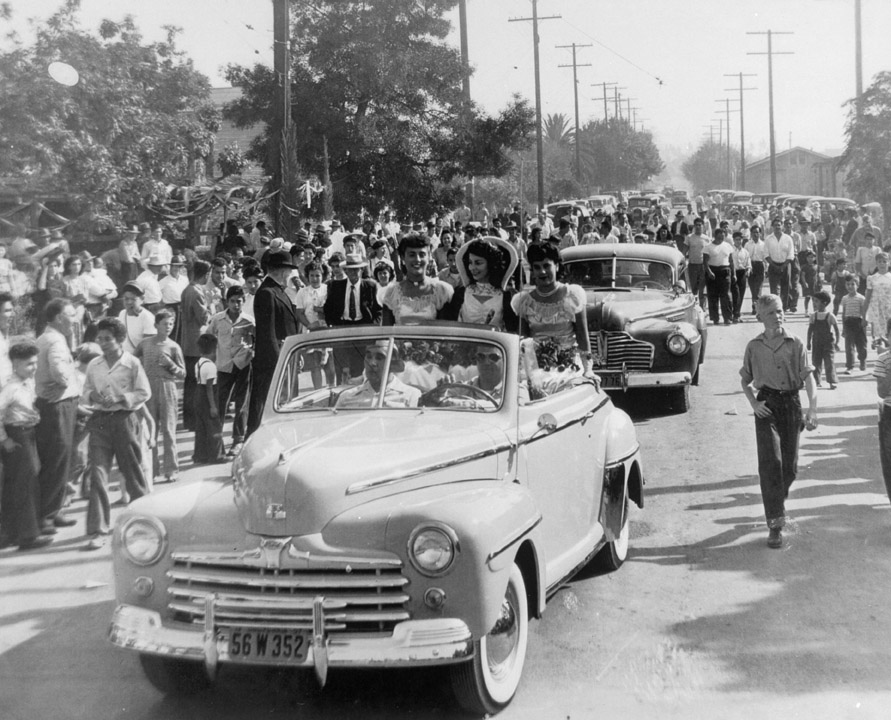
Queen Irene Cruz and her court being escorted to a winners’ platform during the annual Jamaica Fiesta (a harvest festival) held on North Cypress Street, summer, 1947. Courtesy of “Shades of Orange” collection, Orange Library.
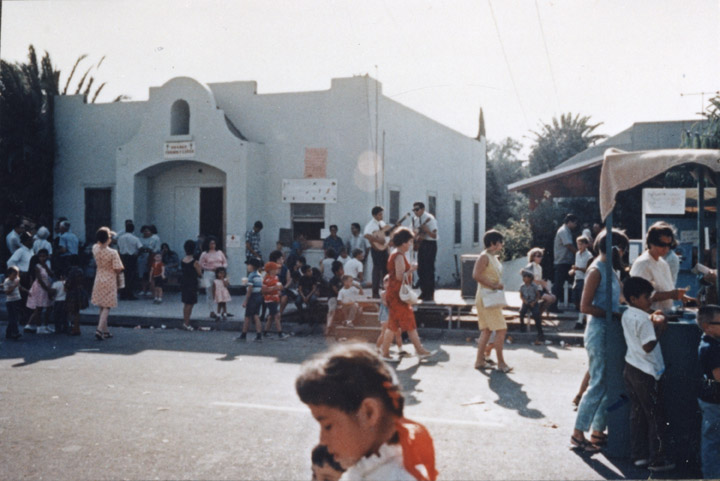
La Jamaica Festival outside the Friendly Center on North Cypress Street, Orange, California, September, 1966. (The “Friendly Center,” built by Quakers, still stands; and is next door to Emigdio’s mural.) Picture courtesy of Orange Library’s “Shades of Orange.”
One thing Uncle Paul is adamant about is that the neighborhood was NEVER violent, NEVER dangerous, and never had ANYTHING you or I would think of as a “gang” in today’s fearmongering parlance. Not back when he was young, and not in the past thirty years either. “You know what passed for gang warfare around here? We would throw wild horse melons  at the kids on the other side of the tracks, and they would throw them back at us.” WILD HORSE MELONS? “Yeah… I haven’t seen ’em around in years… they grew right out of the ground, especially by the tracks, they were 3-5 inches around… you could boil ’em to make soap, they weren’t as bad as rocks but they HURT when they hit you!” (Sounds like he means CITRON melons, small nasty things that apparently grow near citrus trees.)
at the kids on the other side of the tracks, and they would throw them back at us.” WILD HORSE MELONS? “Yeah… I haven’t seen ’em around in years… they grew right out of the ground, especially by the tracks, they were 3-5 inches around… you could boil ’em to make soap, they weren’t as bad as rocks but they HURT when they hit you!” (Sounds like he means CITRON melons, small nasty things that apparently grow near citrus trees.)
This comports with everything else I hear about the OVC barrio. The notion of scary criminal gangs in every minority neighborhood, a notion developed in the 1970’s, was largely a construction of law enforcement and the media, sometimes self-fulfilling and sometimes not even true, as here on Cypress Street. As in any neighborhood there were always some young people who committed crimes, and they generally ended up in jail where they belonged. But the records show Orange (now AND in 2009) to be one of the less violent towns of its size in the county, and there are higher crime areas than OVC in Orange itself which have never been put under injunction – for example El Modena, with its four or five gangs.  More crime was actually committed in the downtown area by Chapman students, and the last murder to take place before 2009 was by a Chapman student in a drug deal gone bad. [See this scholarly paper, Negative Impacts of Gang Injunctions: Vasquez v. Rackauckas, by Gabriela Hernandez et al.]
More crime was actually committed in the downtown area by Chapman students, and the last murder to take place before 2009 was by a Chapman student in a drug deal gone bad. [See this scholarly paper, Negative Impacts of Gang Injunctions: Vasquez v. Rackauckas, by Gabriela Hernandez et al.]
And when District Court Judge Valerie Baker Fairbank (right) demanded to see this allegedly dangerous gang neighborhood, she was driven up and down the streets with a police escort… stared quizzically at the clean neighborhood, notable lack of graffiti and dearth of tattoo’d youth, muttered something like “What the heck are they talking about?” And then ruled roundly against Tony Rackauckas’ gang injunction. And had her ruling upheld last month.
*****Imperial Chapman*****

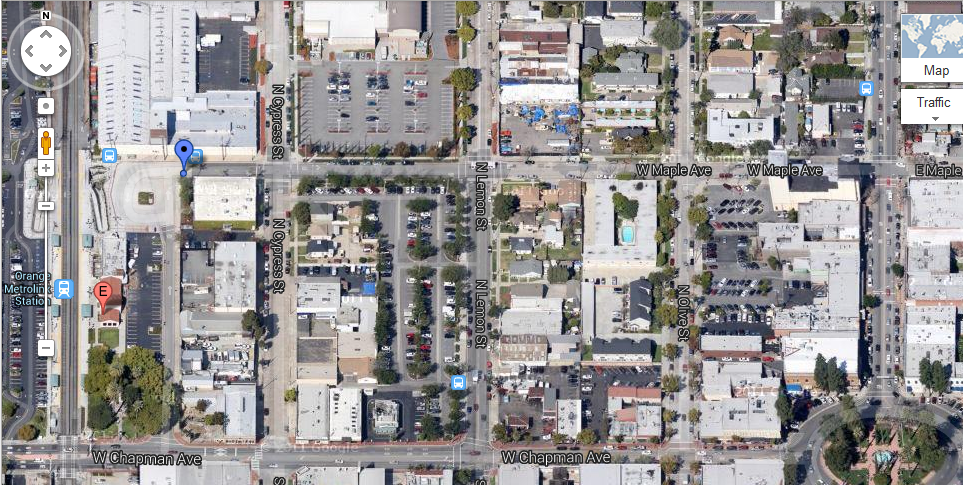
Manifest Destiny? The aerial view from Chapman’s main campus to the Metrolink station includes the heart of the gang injunction zone. Click for larger view.
The obvious suspicion is that a Gang Injunction in Chapman University’s neighborhood, in an area that notably didn’t need such a draconian measure, must have been done for the benefit of Chapman. Uncle Paul, an owner of multiple properties who’s been combating Chapman’s inexorable expansionism for literally decades, cautions us not to be too simplistic and conspiratorial. “There are lots of reasons a gang injunction can happen, but the main one is the police wanting to control minority areas and poor areas.”
True … but you can’t help but look at the facts on the ground, at who’s benefiting. People affected by the injunction have mostly moved out. The property values have gone down dramatically as a result of the injunction. Code enforcement has also been brought in frequently, demanding unreasonable, unaffordable repairs from poor elderly residents. And Chapman has been buying up properties throughout the neighborhood, often for less than the owner wanted to sell. Walking down those streets with the locals, it’s all “Chapman just bought that. And that too. THAT owner will never sell to Chapman though.”
The University’s well-tended wikipedia page boasts,
“Chapman began an aggressive, ten year construction program with the opening of Beckman Hall in 1998. And in 1999, Chapman launched its largest fundraising effort ever—a $200 million comprehensive campaign for facilities, programs and endowments—which surpassed its goal and drew in $214 million by the time it ended in May 2002.” … and then continues in great detail.
Uncle Paul, a veteran of decades of negotiations with Chapman (and hence perhaps possessed of a little more respect and caution than the rest of us have) tells of years of ups and downs in the university’s relationship with the community since they acquired the old Orange High School campus in the early 70’s. The small, 5-member city council shifts from year to year between a majority that’ll give the university anything it wants, and a majority responsive to homeowners (white AND latino) who don’t want dorms moved in next door.
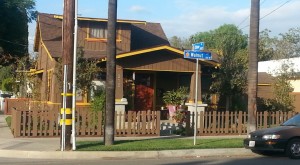 Partly in response to a controversial $3million parking structure, built by Chapman and the city together using taxpayer money, an ordinance was passed – still in effect – that the university couldn’t BUILD anything new unless it acquired all the properties on that block. And there are always some stubborn homeowners who will refuse to sell. In response to THAT, a mysterious realtor began prowling the town trying to buy up properties and denying any connection to Chapman – but clever detective work uncovered his firm as a front for the university – he was a “blockbuster!” In any case, through all the ups and downs over the years, Chapman IS gradually acquiring everything between its main campus and the train station, including this lovely house to the left, which they managed to get for a lot less than the owner wanted.
Partly in response to a controversial $3million parking structure, built by Chapman and the city together using taxpayer money, an ordinance was passed – still in effect – that the university couldn’t BUILD anything new unless it acquired all the properties on that block. And there are always some stubborn homeowners who will refuse to sell. In response to THAT, a mysterious realtor began prowling the town trying to buy up properties and denying any connection to Chapman – but clever detective work uncovered his firm as a front for the university – he was a “blockbuster!” In any case, through all the ups and downs over the years, Chapman IS gradually acquiring everything between its main campus and the train station, including this lovely house to the left, which they managed to get for a lot less than the owner wanted.
The 2009 Gang Injunction desmadre.
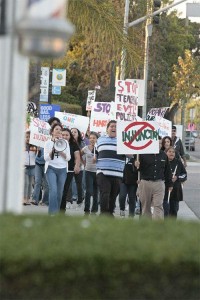
The community reacts to being tarred with a gang injunction, 2009. Picture from the Weekly.
SO. This nice neighborhood was caught totally by surprise when one pre-dawn morning in Feb. 2009 SWAT teams busted into dozens and dozens of sleeping homes, hollering with guns drawn and brandishing 6-inch-thick “preliminary injunctions.” Right here is where you should leave my story and read Daffodil Altan’s amazing account in the Weekly of the events of that Spring – I can’t do it justice like she did.
But to summarize – there are two kinds of gang injunctions. The first one the DA and OPD tried to pull off was the kind where individuals are named as gang members and placed under injunction; in their zeal to show how perilous the neighborhood was, and their hubris in never having been challenged before, they served 115 people, most of whom had no criminal history, or none in over a decade. About half of them were MINORS, with no criminal history at all.
If you read Daffodil’s tale, which I am condensing brutally, you also read about community organizer Yvonne Elizondo and her nonprofit “The Bridge,” which serve(d) at-risk, low-income young people, helping them keep out of trouble, stay off drugs, find work and stay in school. It was Yvonne that the kids of the neighborhood flocked to after being served, and she helped them fight back. And the first thing they did was petition – unprecedentedly en masse and successfully – to have Judge Daniel Didier (a law-enforcement yes man who had never met a gang injunction he didn’t like) replaced with a judge who took his responsibilities a little more seriously – the “no-nonsense” Kazuharo Makino.
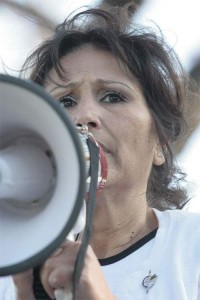
Elizondo. Before being driven out. Pic from the Weekly.
There are some memorable scenes from that first hearing under Judge Makino that Daffodil omitted because she wasn’t around yet: The Orange PD, seeing 50+ teenaged accused gang members congregated in the courtroom to petition for justice, attempted to arrest them all for breaking the injunction, until Makino read the cops the riot act. One kid, making the mistake of taking an elevator with cops, got beat up by them in the time-honored way: blows in the places that don’t bruise. Cops sitting behind Yvonne as she testified loudly joked about her ass.
Fast forward to the April 2009 hearing: Makino saw clearly that the minors were in a Catch 22 – the 50+ minors attempting to removed themselves from the injunction,
” if not represented formally by a guardian (which involves an application process through the court), cannot obtain an attorney. And without an attorney and legally appointed guardian, the injunction is voidable. ‘A judgment against a minor is voidable by the minor at any time,’ Makino told prosecutors. ‘So why should I issue a preliminary injunction that is immediately voidable?‘”
By the next, May 7 hearing, by which time the ACLU had taken on a few of the cases, and fabled Long Beach civil rights attorney David Haas a few more, and it was clear that Makino was going to let all these kids off the hook, the DA surprised everyone by moving to dismiss the case. “I have a bad feeling about this, Luke,” Han Solo might have said. Sure enough, within days, T-Rack’s gang was back attempting the OTHER type of gang injunction – the LA style – where all you name on the injunction is a “gang,” and then at your leisure decree which men, women and kids are part of that gang. And they DON’T get to argue they’re not part of a gang until after they’ve been arrested for violating the injunction, which almost never works.
Long story short, that is what Judge Fairbank ruled unconstitutional two years later in May 2011, a ruling upheld by the Ninth Circuit Court of Appeals last month – that “being subject to a gang injunction restricts a person’s basic liberties and that whether or not someone is a gang member is a complex factual question that shouldn’t be decided solely by law enforcement.” (LA Times summary.)
So … it’s all good, right? Well, let’s see what this victory really looks like on the ground…
Vasquez’ Pyrrhic Victory Against Rackauckas.
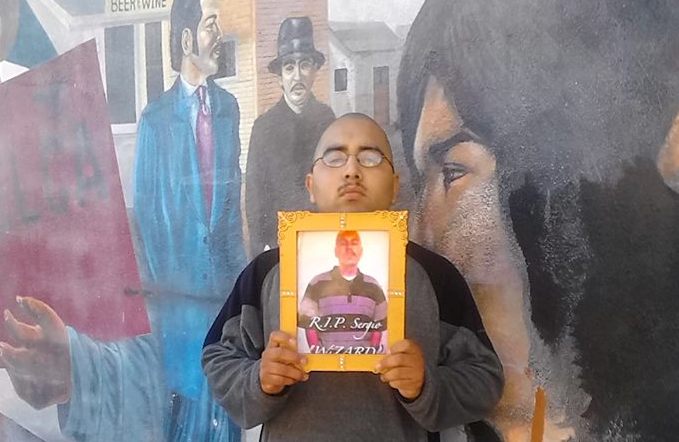
Three Vasquezes. Lead plaintiff Manuel holds picture of his murdered brother Sergio, in front of Emigdio Vasquez’ celebrated and controversial mural (no relation.)
“…and then, toward the end of the Civil War, the slaves were freed … not so you’d really NOTICE it of course, just sort of ON PAPER.” – George Carlin, 1984
NOW it was personal. Not only did the authorities – the police, DA, city and/or Chapman or whoever, want these people out of the neighborhood for their own reasons, even MORE importantly, now that they were fighting back legally – as NOBODY HAD EVER DONE BEFORE – they HAD TO BE MADE AN EXAMPLE OF.
Orange cops just continued, and continue, to behave as though the Gang Injunction is fully in force, with raids, arrests and harassment – and who in the OC is going to stop them? As I ask after the young people named in Daffodil’s story, “Oh, he finally moved out of the neighborhood. Oh, SHE gave up and moved out too.” And Chapman continues to snap up properties at bargain prices.

One law-abiding home after Orange cops trashed it on the night of November 13. (I hate to say it, but this is sometimes what my own teenaged son’s room looked like WITHOUT getting trashed by Orange cops.)
The ACLU’s office was vandalized repeatedly, had its internet and power cut repeatedly, and eventually moved out. The feisty Elizondo gave up and left town as well, after endless harassment and targeting of her teenaged children by the OPD. Her nonprofit “The Bridge,” after so many years of vital work in the community, was stripped of county funding and forced to shut down. Real portraits in courage there, Board of Supes. Dangerous group of enemies to make, the OC DA, local police department, and maybe Chapman.
And then late on the night of Wed. Nov 13 – about a week after their “defeat” at the 9th Circuit, enraged Orange cops broke into the houses of at least ten of the “victorious” defendants, holding guns to their heads, ripping up their homes in the vain search for SOMETHING incriminating, and demanding (unsuccessfully) that they admit to being gang members and sign the notorious “STEP card” (which every responsible working-class minority parent warns their kids to NEVER sign.)
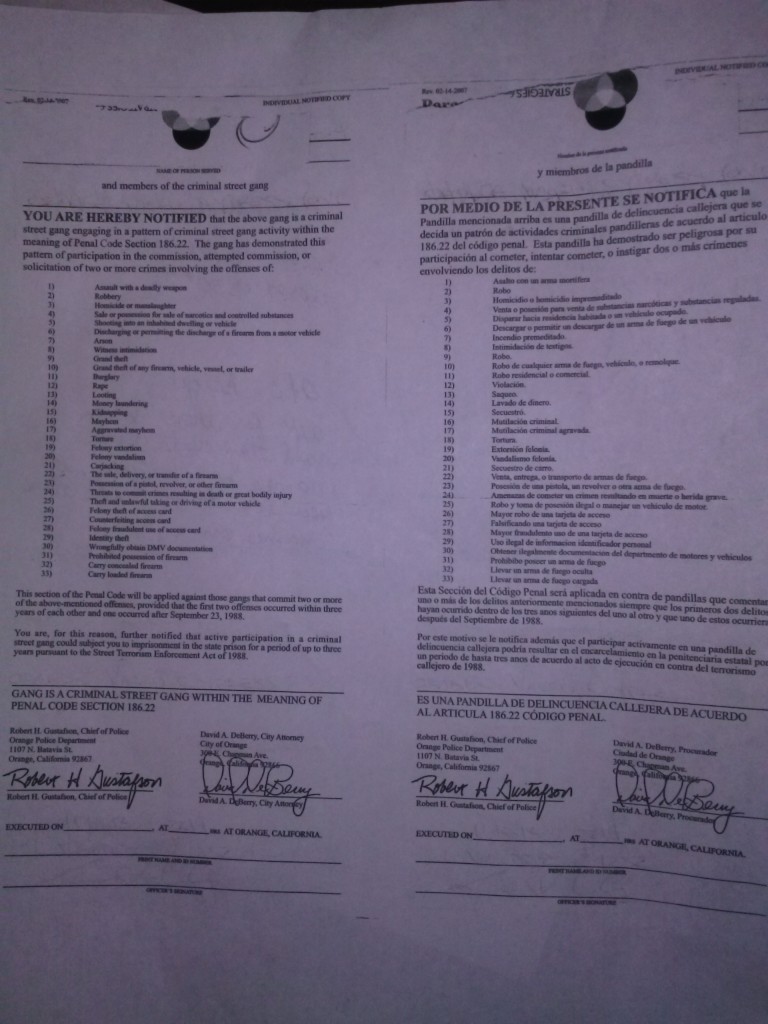
A “STEP” card. If you’re a kid walking home at night in the wrong neighborhood, cops will cajole you or threaten you into signing one of these. Don’t. A gang association will follow you the rest of your life. Click for larger image.
And who can the community turn to now? It’s not surprising that these folks say, “Well, if this is what VICTORY looks like…” and then wearily don’t finish the sentence.
Cops and “Criminals,” and the Murder of Sergio.
When you hear talk in Orange about “the criminals,” it’s probably not in reference to generic criminals, it’s probably in reference to the “O.C. Criminals” or “OCC,” a gang of wanna-be first-generation Mexican troublemakers who started out in Santa Ana, kinda petered out there, and are now centered in Orange a mile or two east of the OVC Barrio. To all appearances their main purpose these last couple years has been to try to start trouble in the neighboring OVC area, to try to provoke a response – it’s tempting to suspect at the cops’ urging, as when they start a fistfight the OCC guy will get a slap on the wrist or a few weeks, while the OVC guy will get months. “The Criminals are RATS!” as the OVC people put it. (No, I have not made the acquaintance of a “Criminal” to get their side of things.)
The “Criminals” had a gang injunction put on their neighborhood a year before OVC; it has never actually been used against them, but presumably provides some leverage as they do the cops’ dirty work against the REALLY dangerous people: the century-old neighborhood that is squatting in Chapman’s path, and which has the temerity to fight back!
But on this last July 3, on a sunny afternoon, a shark was jumped of the tragic sort:
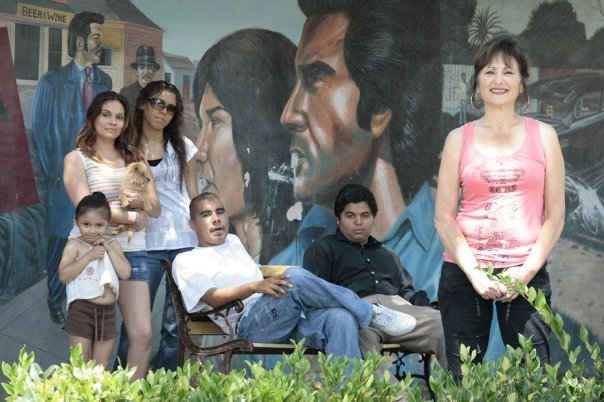
In front of Emigdio’s mural: Yvonne is to the right, and Sergio is the shaved-headed young man seated to the left. Pic from the Weekly.
Sergio Vasquez‘ first arrest was for defiantly sitting in front of the above mural, which the Orange Police had ridiculously labeled “a gang mural.” All his other arrests stemmed from that and from the gang injunction which has repeatedly been ruled unconstitutional – arrests for hanging out with his big brother Manuel and other friends, for being out late, and for venturing into “forbidden zones.” So by any fair accounting, Sergio led an entirely crime-free life. A straight A student, he earned the nickname Wizard for his skill at science and math.
Last July 3, in the middle of the afternoon, at the age of 20, Sergio was shot in the head with a 9-mm hollow point bullet, by a passing white van driven by a young woman. Witnesses were not able to catch the license plate number, but police were there within a minute, almost as if they’d been expecting this. When paramedics arrived, witnesses heard the police order them to stay away from Sergio’s still-living body: “He’s a gang member, leave him alone.”  There was no evident effort to pursue the attackers, but police took the opportunity to raid a lot of houses in the neighborhood – remember, the final hearing before the 9th Circuit was fast approaching and the cops were desperate for any kind of evidence to confirm their baleful descriptions of the scary OVC “gang.”
There was no evident effort to pursue the attackers, but police took the opportunity to raid a lot of houses in the neighborhood – remember, the final hearing before the 9th Circuit was fast approaching and the cops were desperate for any kind of evidence to confirm their baleful descriptions of the scary OVC “gang.”
What are the chances – the law-abiding kid brother of the lead defendant in a suit against the DA?
Just as in the Third World, where there is no trust of the government, no trusting relationship between law enforcement and the people, the people live on rumors. There’s a rumor now that an arrest was made in the case. Who knows? The detective in charge of the case, a Detective Jevec, won’t tell Sergio’s mother anything (or even let her have his stuff), and it’s been five months now. I tried calling Detective Jevec and he sure wouldn’t tell me anything. He referred me to the Orange PD’s Public Information Officer (PIO) who referred me to the Watch Commander, who referred me back to the PIO, and none of them have returned my calls.
Another rumor is that members of the Criminals came by later and threatened Sergio’s mother and brother Manuel that “you’ll be next,” but those two won’t confirm or deny that, so who knows?
What IS documented and videotaped is the OPD’s post-murder harassment of the grieving neighbors and family. Chicanos Unidos has documented and videotaped the all-day harassment of the carwash the neighborhood held to raise funeral costs, and the police’s constant dismantling of any attempted “shrine” to Sergio’s memory. As you can see to the right, neighbors and family will occasionally place votive candles in front of the telephone pole on the corner where he was shot, but police always remove those, and have threatened Sergio’s mother with $2000 fines for each time they “have to do that.” So most of the time his shrine is just a pole filled with rusty nails.
And some deputy DA had the cojones the other day, in a Santa Ana meeting about gang injunctions, to try to use the murder of Sergio as a justification for why gang injunctions are important. Yes, a policy that made this young man’s final four years into a prison and did nothing to protect him from getting gunned down by the cops’ pet gang. That deputy DA, I understand, was shouted down.
Emigdio’s “Proletariado de Aztlan.”
We keep going back to this mural, at the heart of the barrio, which was famed Chicano muralist Emigdio Vasquez‘ 1979 master’s thesis, funded by Cal State Fullerton. For decades this mural was considered a seminal early work of a great and prolific artistic cataloguer of history, until suddenly in 2009, much to Gustavo’s snarky amusement, it was declared a dangerous piece of gang-glorifying art.
 A couple of OG’s (guys my age included in the injunction but who haven’t otherwise been in trouble with the law in decades) told me that they thought the problem was the “picture of Che Guevara” toward one side (see detail at right.) I looked and said, “Well, that’s not really a picture of Che, it’s a picture of a picture of Che. The muralist is showing that at one point some local people painted Che on a fence.” They agreed, and actually showed me the original fence, a couple blocks away, that used to have Che on it, and is now almost obscured by tall bushes.
A couple of OG’s (guys my age included in the injunction but who haven’t otherwise been in trouble with the law in decades) told me that they thought the problem was the “picture of Che Guevara” toward one side (see detail at right.) I looked and said, “Well, that’s not really a picture of Che, it’s a picture of a picture of Che. The muralist is showing that at one point some local people painted Che on a fence.” They agreed, and actually showed me the original fence, a couple blocks away, that used to have Che on it, and is now almost obscured by tall bushes.
Uncle Paul says the mural is full of neighborhood characters from the 40’s to the 60’s. He can name almost all of them (including his brother in the zoot suit.) HE says that the cops’ excuse for calling it a “gang” mural is that someone at some point made that black car’s license plate read “OVC” … although that was quickly removed.
Also, see that big white smudge in front of the car’s left front tire? That was the OC Criminals’ attempt at defacing the thing (they also tossed white paint at the pachuco’s girlfriend’s mouth, making her resemble a werewolf lady.) I said, “that smudge isn’t so bad, it looks kinda like a splash of water on the car.” Laughed the OG’s, “That’s exactly what Emigdio said, he said keep it!”
Here’s one thing: We mostly only see the side of the mural facing Cypress Street, it actually starts out on the south side which is even bigger. Here’s a view from the corner of the building:

Well, the sun screwed up the south side there, so here’s a NICE picture of the south side. I’ll get Paul to give me more details about the people here:

Something else to know: The owners of this building DID finally sell to Chapman, BUT they did make Chapman put in writing that they’d both restore the mural to its original condition AND keep it there in perpetuity. No problem, I imagine – Chapman may be insatiable for property, but unlike the Orange cops they do have an appreciation of historic art. (I tried to get the OG’s to pose in front of the mural, they thought that would call down more heat on them from either the cops OR the “Criminals”, so instead they took MY picture. Does this make me a gangster now?)
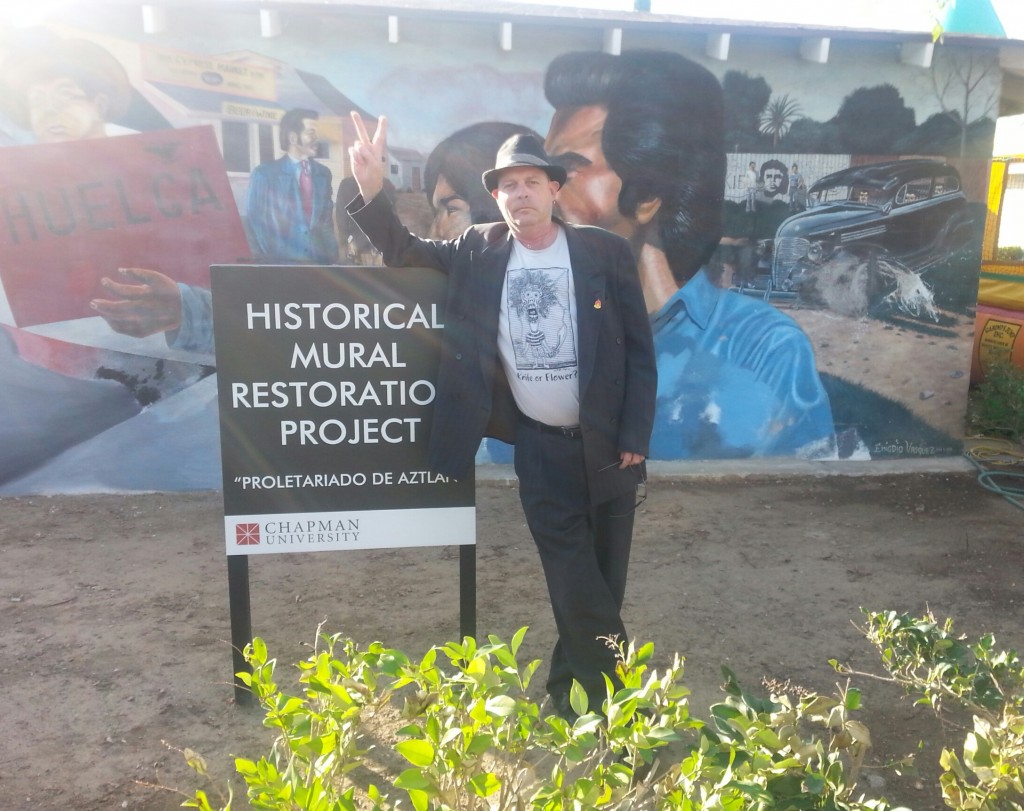
Finally, Emigdio, who also painted the Little People’s Park mural in Anaheim which is sorely in need of renovation, is now 72 and in failing health with a chronic illness. I urge you all to see a slideshow of his beautiful work at his website – most of it actually is a lot better than the above.
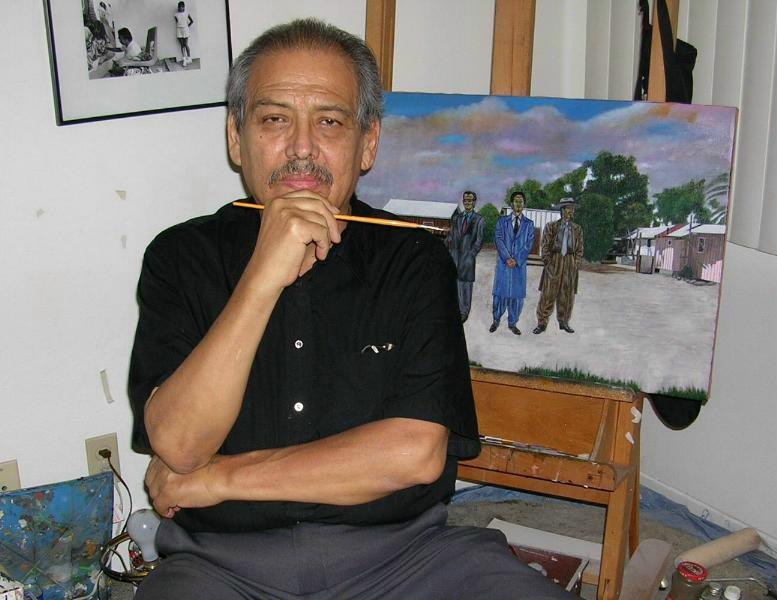
Emigdio Vasquez, born 1939 in Arizona.







Well thought out and written, devoid of any of the “I live in XXXXXXXXX but want to tell lesser among us (socio-economically speaking)political bullshit that generally surrounds these arguments.
I am super impressed and will evaluate this from the “gentrification” standpoint. But, how does this argument the similar “rumored” pending injunction in nearby central Santa Ana, an area far less diverse, which includes multi-generational felons.
I believe that injunctions are a powerful tool, and must be used as such. Having said that they are NOT all bad or a CURE ALL. While that’s hard for some of us who don’t have choppers hovering over our apartments EVERY night, it is reality.
a couple of years back we had a similar situation. at the trader joe’s in crystal cove two large black men and a hispanic were congregating in the parking lot, looking very suspicious. it caused a lot of concern. the police were called, the helicopters hovered and we knew what it was like to live in one of those neighborhoods. it was scary and many at the time wished that an injunction similar to the one in anaheim was in place. after a standoff lasting several hours and an extensive investigation, it was determined that the two black men were kobe bryant and karl malone and the hispanic was some guy who played for the angels. the point is that one cannot be too careful
That isn’t funny.
Okay, yes it is.
willie, I hope they’re not still saying “N. I. N.” on their police radios down there…
You always have to ask yourself: WWDAWSPDD* do?
What Would a DA With a Severe Personality Disorder Do?
As I’ve stated on blogs and at the podiums of the Anaheim and Garden Grove city council, your law enforcement community are nothing short of a mafia trash criminal organization. These imbeciles are capable of attempted murder so by default it means that this trash is capable of murder. This trash law enforcement community also uses white/latino gang member types to commit crimes for them. I state this because I am a victim of it and have declared so. Unfortunately, the city of Anaheim and Garden Grove, this District Attorney Tony Rackauckas, this County, Loretta Sanchez and the Federal Bureau of Investigation all stuck their heads up their asses when I asked for help.
So this won’t end until these pieces of traitorous garbage are residing in federal prison and the whole world is too busy throwing up on Disneyland and the rest of this cheesy entertainment complex to be bothered attending this mafia trash hick hole.
And all I ever wanted to be Vern was a Hispanic American practicing engineer in Garbage Grove, CA.
In summary, your disgusting racist rathole of a police community thought that they could treat even the latino guy working on law enforcement stuff in Colombia for the American company of white American heroes as if he was a gang member. What this means is that these maggots think that they can point to any Hispanic man here and screw them.
And this is why the reputations of Stan Knee, Joe Polisar and Kevin Raney of the Garden Police department, Brad Gates, Mike Carona and Sandra Hutchens of the Orange County Sheriffs department, Randall Gaston, Baker, John Welter, Raul Quezada of the Anaheim police departments their contemporaries at the California Highway patrol and assorted other mafia trash will be flushed down the toilet bowl of American history for being police leaders that acted like criminal assholes around the turn of the 21th American century. And if people like this DA want to join them then bienvenido. My personal thank you for ruining my life American traitors.
German Santos – American
I would sure like to hear from Todd Spitzer how he would have handled this? Or if he would have placed an injunction in the first place.
How about martial law?
that assumes two things, first, that todd knows what an injunction is and second that todd can find the courthouse
The second one is no problem.
Just put a microphone in front of the courthouse. (rimshot!)
“Pearl St ~CPLS X3~ Apr 27, 2012
Fuck mocas they ain’t shit stupid snitches that’s what they r good at got paperwork on those putitas they wanna claim something that they r not …achu Ohh spensa ……we tree them out of hamlin that’s why they don’t kick it n e more we stomped them at vine that why they ain’t around n e more and Fuck the rest cuz this is big bad PEARL ST GANG LOS J BOY EAST SIDE ORANGE COUNTY BIG BAD ONE N ONLY SLIMFOR THE HOMIES DOING TIME KEEP UR HEAD UP PERRITOS A BULLET AND MORE FUCK IT REAL TIME WE AIN’T PUSSYS WE DO OUR CRIME AND DO OUR TIME pocos pero locos take n e one saludos to the homies MALO,SILENT,CREATURE,WICKED,GIANT,BOXER,FELON,STRANGER,BRUJO,NECIO,POSTE,TOKER,SUSPECT,DARKS,VANDAL and all the other homies in the pinta doing tiempo and to the homies in the outs we ready for n e mother fucker trying to step in our territory’s”
Um… thank you, skally … for the rantings of i guess some gangbanger somewhere in the county. Excellent contribution!
I thought that you might like to have those guys as your neighbors.
Pretty dumb. You probably didn’t read my story. These OVC people WERE my neighbors for three years. That doesn’t sound like one of them.
Are we marinated in any kind of prejudice this morning?
I am prejudiced against thugs, killers, & drug dealers of any color.
I agree with your criticism of the CIA.
This guy is Pearl St. gang – El Modena – north of Chapman & Hewes.
Yeah – exactly – the folks T-Rack DOESN’T go after, because they’re not in the way of the expansion of a big mover and shaker like Chapman.
This highlights a common problem that you and Diamond both have with your articles. You write good articles, but you don’t boil it all down into a finishing paragraph or two that states the basic problem and how you think it could be solved.
Couldn’t do it here, dude. Just too much interesting stuff, all inter-related. When I write one of these epics, you just gotta block out a little time for it.
That’s amazing. So you do read them all the way to the end?
Yes – but some paragraphs I read only the first sentence.
That sounds extremely burdensome. Thank you for making that sacrifice.
So if I understand you correctly, you have no idea whether your allegations might be refuted by anything *after* the first sentences of those unlucky paragraphs.
I made no allegations here – nor do I usually make allegations on any matter at hand. I do however make observations and state my opinions. Feel free to refute.
Probably not worth doing if your answers are already buried in the paragraphs above.
Youre a fuckin Momo. I grew up in El Modena. Its not even close to being as crime ridden as the OVC or rest of Orange area. Much of the issues in the Elmo area are due to the fact that a large population of Hispanics from nations other than Mexico came to the US and various barrios during the 80s. if you know anything about Hispanic culture you know that all Spanish speaking nationalities literally hate Mexicans and Chicanos.
uhhh … nice to know Paul ….. I think …. maybe not so much …..
that may be true, but they love their gardeners
Paul is talking about the Central Americans etc. that moved in there recently. Doubt they have gardeners.
Anyway he’s contradicting himself. First he says El Modena’s not violent cuz he grew up there 40 years ago and remembers it not being violent. Then he says the only reason it’s so damn violent is because Central Americans moved there in the 80s and they hate the Mexicans. WHICH IS IT??
I think Paul is also Anitabonghit.
No no no. Paul HAZZA bonghit.
I know Anita. He lives in Newport. Probably near Alice Cooper.
fake ass made up gang the only reason you guys are around is bcuz all the vato locos from motown were locked up not ten heads like you name try 50 bitch…
The two greatest and most relentless murderers of neighborhoods (if you don’t count the government): hospitals and universities.
hey, you want some serious gang bangers, check out the crystal cove cowboys,, especially saturday mornings at pacific whey,,,those are some scary people
OK I have to offer a conflicting viewpoint on the numbers. The injunction area you show here overlays the entirety of the Old Towne Orange Historic District (yes the extra “e” really is there, don’t get me started.) Now anyone who has tried to even swap out a door bell in Old Towne understands it doesn’t happen without an EIR, and the blessing of the OTPA (their local preservation group of usually awesome people) so if Chapman is tearing stuff down they are getting around rules the rest of us jump through SERIOUS hoops for (I will tell you someday about the barn story) also the Realtors have hyped the Hell out of Old Towne, and their property values are pretty extreme in comparison to Historic Districts in surrounding communities. So if the locals are being low balled out of their bungalows they missed the memo on what their homes are worth.
But for the DA to claim that area as gang infested blight….really? The only thing scary about Old Towne is trying to keep an antique shop open when the landlord wants to put in yet another boutique bar and grill for many times the rent you are paying. Come on T-Rack, I would bet the vast majority of residents and business owners in the area have NO idea they live in a gang injunction zone….not one of my clients in the area has ever mentioned it, nor do they mention gangs, unless you count the roving bands of drunken co-eds partying their freshman year away in the house Mommy and Daddy leased for them. This is freaking ridiculous! And now it is time to start the pool on how long it takes Matt C or his screen personas to write a post on Cynthia Ward being a gang member who openly advocates for criminal activity. Who wants the first pick on that? I say $20 on 6 pm today.
“So if the locals are being low balled out of their bungalows they missed the memo on what their homes are worth.”
Exactly!!
But who cares what the designated gang injunction area encompasses? Those gang critters can hump it a couple of blocks.
The Orange County gang member problem is the biggest Madoff con ever hoisted on any group of Americans anywhere. I’ve lived in Orange County for 32 years – half the time in Garbage Grove and Anaheim and the other half of the time in Anaheim Hills and South Orange County. The only time that I have ever had any problems with gang members is when your mafia trash act of a police community used them to harass and intimidate me, damage my property and attempt murder. Your police wouldn’t dream of solving any existing gang member problem because it’s their meal ticket – so much so that they are actually instigating the problem.
I believe at the Anaheim city council podium that I referred to this gang member problem con as “an endless cycle of criminal insanity where the only winners are these cops with their ridiculous salaries and pensions”. Pensions even while residing in federal prison.
Thx for this important article Vern. Far too often T-Rack’s actions go unnoticed and contribute to his abuse of power. I am sickened by how much of our tax payer $ has been wasted on this case – all because of his personal vendetta. It’s critical that community members be aware of laws that camouflage hidden agendas. Gang injunctions have nothing to do with gangs but with gentrification, martial law, oppression, life time sentences without having to prove guilt, racism, classism. When people hear the word “gang” they automatically check out. They don’t realize the repercussions it has on communities. Many people who have no associations to gangs are placed on this injunctions or gang databases (even without their knowledge).
Here are some of my thoughts:
– $4 million does not include fees paid to the costly civil law firm the DA’s office hired to represent them in civil court. Fees do not include fees to produce the gang injunction which roughly costs $500,000. Fees do not include the full time officers and prosecutors needed to enforce the gang injunction.
– More lawsuits will come out of this lawsuit and tax payers will continue to pay.
– There are over 2,000 documented white supremacists in OC and a gang injunction has never been imposed on them although OC has experienced anincrease in hate crimes.
– District Judge Fairbanks was actually appointed by Pres George W, she is super conservative but by the book and OVC gang injunctions was by T-Rak’s book.
– We have been informed that Chapman Univ Students have been condescending towards Orange High School Students although Chapman Students are the real outsiders.
– Yvonne Elizondo’s Bridge Program was the only youth and adult re-entry program in OC.
– Orange Police Department officers have such a hostile relationship with OVC community members that police complaints have to be submitted to OC Public Defenders office.
Thanks for your kind words and additional remarks, Gaby. But when you say “Chapman Univ Students have been condescending towards Orange High School Students although Chapman Students are the real outsiders” I think…
Well, hard to measure how much race and class might be involved, but OF COURSE college students are “condescending” to high school students – college students are unimaginably hip, cool, and smart, while high school students are silly immature DORKS. DUH. HELLO.
Sounds like whitey making excuses for racism to me.
Yeah, but everything sounds that way to you, so we know to discount it.
hey, I have never made an excuse for racism
Maybe — but you misspelled “Why’d he.”
I’m a fifth-generation Cypress Street descendant of the founding families of that community. On one side of the aisle all of them drive from Cypress Street and on the other side from El Modena. I can agree more than ever. There was definitely an accelerated behavior influence and push to disrupt the community as a whole in order to gentrify the entire sector of Old Town. This influence was done because the real estate had become the lucrative component weather University became just that. A university instead of a college. This drove prices through the roof along with expectations plans and growth that all had to be approved by the city officials. Each process had to be approved by DRC then planning and then approved and voted on by city council. Every time it seemed to be that nobody would have ject to it and that the argument was the area needed it because it was an unwelcoming and taboo sector of the district. This progression started in the late 80s but was fended off when the Old Towne preservation group at the time was constructed of actual deep-rooted generational descendants scattered throughout the entire Old Town District disregarding your racial origins. The group was more fierce and more willing to come back the corruption that worked hand-in-hand with the progressive and volatile attack on that community
Now make no mistake yes there was criminal activity taking shape we all understand that. The Gang had its roots and ties to that community as it derived and connected by three components. Culturally, generationally and by the actual name which explained in Spanish the location of it. Yet removing the effects of the gang in this discussion or issue give no credence to why they had to sweep the area and hand it over by approval of a specific plan that has been modified and resubmitted countless times by University to disrupt and persuade lifelong residents to leave the area. Residence that are key components to the desegregation I’m not only the city but also West coast wide! The value historically of what we had living here how to take a day could have been swayed away from the criminal effects that Drew such a bad light upon us if and only if true leadership and City officials had merged these efforts and finally truly had completed the assimilation of allowing these Hispanic families who had proven their worth during the multitude of wars our people enlisted into. If we have been given a loving and helping hand of opportunity without judgment or prejudiceness then maybe the following Generations who were nothing more then a pot a mixed ingredients of emotions heartache and anger would have never evolved into the Gang. People don’t think about that!
As a historian and advocate for this Chicano community, it is our due diligence to finally write the history and the results what occurred from the other side of the aisle but from our perspective. it doesn’t matter if you are Democrat Republican libertarian or just don’t care about politics, it is the job of every citizen of this town County State and Nation to learn from its past discretions to make better and write for the future others Nation. For our next Generations to come, for our children and their children’s children. These mistakes that were made here literally in this small corral, this little spot a soil were the microorganisms innocence that brought about life to what we have today whether good or bad. we need to explain why are people moved here from Mexico and why they did what they did and why they endured what they did. Most of all we need to showcase the positive contributions by the Hispanics so that people who are moving to Orange because of how amazing it seems and unique an historical, that they understand the presidents of what is sitting right here. What is sitting as a symbol of unity that was incomplete and it’s development stages and instead became deformed and ugly because of stupid financial decisions and moves and greed.
My grandfather, my great-great-grandfather started the Jamaica Festival which is now the international street fair yet is that history told? Why is that not shared or at least exposed ever and told that the Mexicans of this beautiful community of old created what you enjoy today. It was celebrated in May which is interesting enough that we used to have a parade which is depicted and it very well known documented photo are the 1940s on Cypress Street. dial the City of Orange wants to return the May festival but with no connection to this Hispanic celebration.
I’m hoping this year for the first time ever with the help of dedicated true longtime residents who have now been elected, some of them actually genetically have ties by DNA to that community…. Are going to help preserve what is left for us to be able to Showcase it. Not for our recognition but the Showcase that the Hispanics where the Piston to the engine that’s started orange on its way. How often do you ever see the Piston head to an engine? Most never do but they enjoy the youth and ability and the strength that the engine produces to get the job done and that’s what we were. That’s what our families and our people were to this city and to the county, yet this is not ever recognized and instead disregarded. I say no more as board member of the orange Barrio historical society as well as the direct descendant of the man who was the community leader on Cypress Street
I’m the grandson of libreto Alonzo
And Romeo Chavez, the two biggest influential individuals of the original founding Generations of Hispanics in this town. Is my lifelong goal to commemorate their efforts and all of their generation the following Generations from my generation for my children’s Generations but the stories be told of the beauty and contributions made to this town.
We can never allow real estate that was undeveloped and purchased and passed down over generation and generation and generation to be looked at as undeveloped land. We can never allow it to be robbed from beneath through the powers a persuasion or money ever again. Every person who owns a home no matter where you live should never feel but they are the target by developers or neighboring growing entities. If I had a Caucasian family being targeted and their history work and lied about in order to take their land I would stand shoulder-to-shoulder with them but unfortunately we have that Gap we need to feel. We need to mend and heal between the different ethnicities in order to stand unified and question the money that’s influencing this gentrification and also those who are accepting of this offers hung in front of them like a carrot on a string. Elected officials are supposed to be of the people and for the people but with this gentrification and destruction that we have seen in this community, this is a prime example no matter how historically significant a building or a people are. Power and money and influence will destroy those loyalties or commitments all responsibilities of these elected officials. I think we have time now to at least stop the clock and show that it is time to make a different move
For all those who have been affected by the wrongs of the police department, I can stand with you and say I too have felt there sting! Labeled criminal but also taking a physical beating well hearing the officer say that people like us need to learn a lesson in order to change their lives. I was the recipient of one of those attacks but there are two things there that came from it. One, it was wrong but he achieved his goal because I did change my life. I became a living breathing example of a law-abiding citizen not because it was my duty but instead I felt I had to prove myself. Yet mixed emotions of anger and disappointment lingered Within me because they didn’t understand why I was willing to do this or that. Instead they still judged me for the mistakes of a child well at the same time never asking the true question if there was something wrong. Instead I went after my fear and almost became a police officer because of it not because I wanted to but because I wanted to stand in the realm proving to them but I could do it just because they said I couldn’t or that we were not worthy. Our people were not worthy of, but by the grace of God I was led elsewhere in a successful career and life. I also felt the sting at the gentrification as my families were uprooted on all sides of the college campus in order to feed the growing beast of the University’s development. I even felt the sting the real estate moguls involved as we were taken advantage of because my mother was an advocate and descendant of the Barrio but also one of the original founding members of the orange Old Towne preservation Association. A true warrior who fought yet after her death and upon the sale of the home items a significant emotional value of hours were taken from us and destroyed for no reason but retaliative action. To send a message yet what it did what’s fuel the desire and the fight within me to carry the torch further once my maturity level was capable of doing so.
To all those who have been affected by this I stand with you. To all the broken hearts and angry youth I understand where you come from. Rest assured things are going to change but we need your support. We need your input and we need to work together. Currently we have a campaign that doesn’t understand this past and doesn’t understand our stories because I’m not one of us yet people try to remove us from the equation while still trying to deliver a resolution to the city what the same time asking for change. We need to be the sentinels of Our own history and Future what the same time working together because we cannot be divisive anymore and achieve these goals.
I also want to see other historic Barrios like El Modena and the placentia barrio in Anaheim or garden Grove preserved. I want to see the Barrio where a lot of my family members bought property in the Santa Ana area of Delhi. There is so much good that can be told and also within the good healing can come about. We are a culture that is an ingredient to the success and development of this state yet or not in the cookbook at least by those writing it